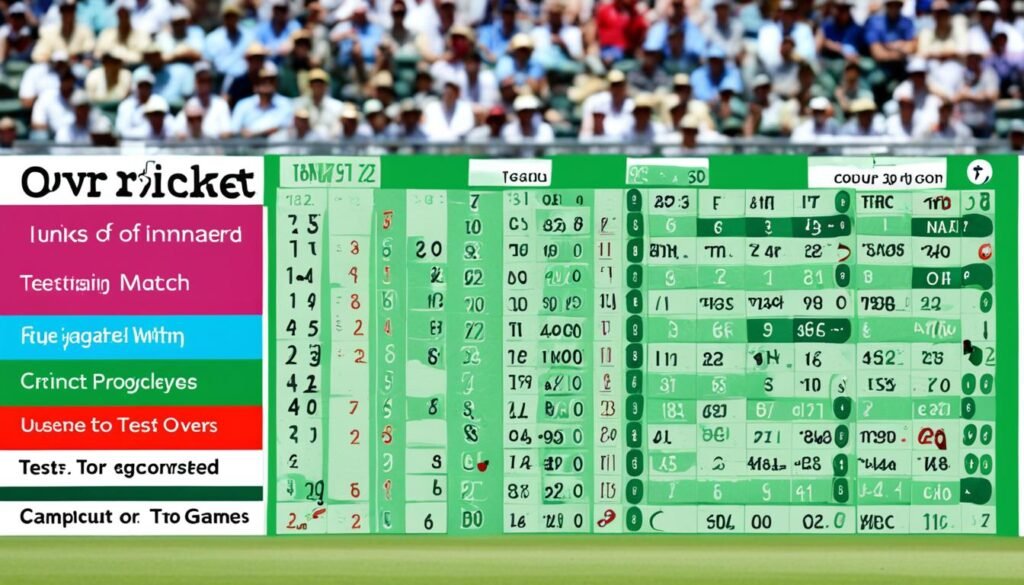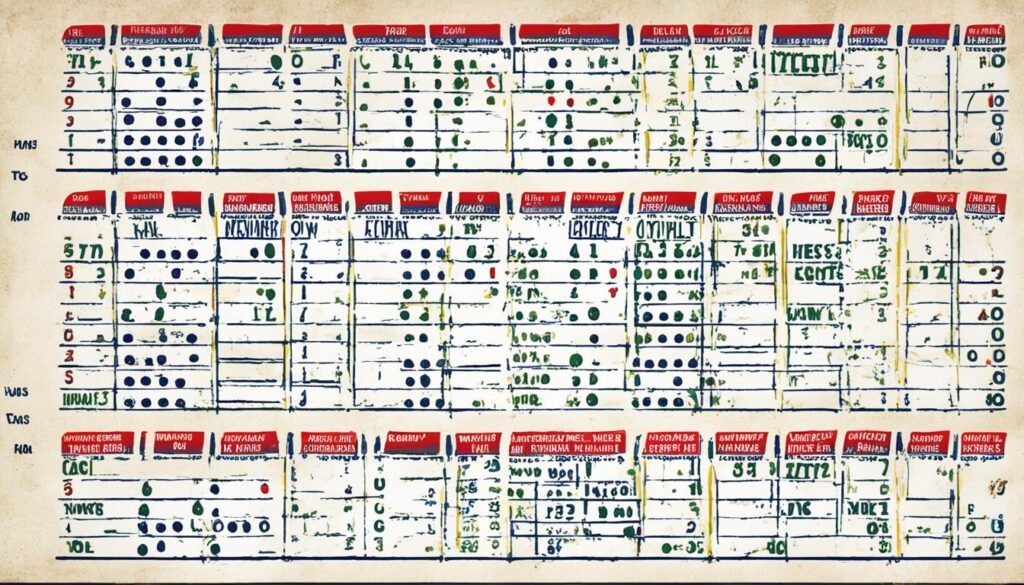Test match cricket is the oldest and most prestigious form of the game, attracting international teams from around the world. In a test match, teams compete over five days, showcasing their skills in batting, bowling, and fielding to emerge victorious. Understanding the fundamentals of test match cricket is crucial for fans and players alike.
One of the biggest test match series is the Ashes, which features a longstanding rivalry between Australia and England. This fierce competition captivates cricket enthusiasts and highlights the rich history and tradition of the sport.
During a test match, each team gets the opportunity to bat twice, with the goal of scoring as many runs as possible. The bowlers, on the other hand, aim to dismiss the opposing batters and take wickets. The team that scores the most runs at the end of the match emerges as the winner.
Key Takeaways:
- Test match cricket is the oldest and most prestigious form of the game.
- The Ashes is a renowned test match series between Australia and England.
- Teams bat twice in a test match, aiming to score as many runs as possible.
- Bowlers strive to dismiss batters and take wickets.
- The team with the most runs is declared the winner.
How is Test Cricket Played?
Test cricket is a traditional and prestigious format of the game, played between two teams, each consisting of 11 players. This ultimate test of skill and endurance spans over five days, divided into sessions, with the ultimate aim of determining the superior team. The match begins with a coin toss on the first day, which determines whether a team will bat or bowl first.
The team batting first aims to score as many runs as possible, while the opposing team’s bowlers strive to take wickets and limit the scoring. Each team gets two innings to bat, with the bowlers delivering six balls in each over.
The match progresses over the course of five days, with play continuing until all the scheduled overs are bowled or all the wickets are taken. The team that accumulates the most runs over the two innings will emerge as the victor.
Test cricket is a true test of endurance, strategy, and skill, requiring teams to excel in both batting and bowling to secure victory.
How to Score Runs and Take Wickets
In Test cricket, scoring runs and taking wickets are crucial for teams to achieve success. Let’s explore the different ways batters can score runs and how the opposing team can dismiss them.
When batters are at the crease, they can score runs by either crossing the pitch or hitting the ball over the boundary. Each time the batters swap ends safely without getting out, they are awarded one run. If the ball reaches the boundary without bouncing, it’s an automatic six runs, and if it hits the ground first and then the boundary, it’s counted as four runs.
However, batters need to be cautious as they can also be dismissed by the opposing team. One way is getting bowled, which means missing the ball and hitting the stumps behind them. Another way is by getting caught, where the fielding team catches the ball without it bouncing after the batter hits it. Batters can also be run out if they are caught outside the crease before reaching the other end.
Other forms of dismissal include leg before wicket (LBW), where the ball strikes the batter’s leg without hitting the bat and the umpire deems it would have hit the stumps. Lastly, a batter can be stumped if the wicketkeeper removes the bails while the batter is out of the crease, attempting a shot.
“Scoring runs and taking wickets are the fundamental elements of Test cricket. Both teams strive to excel in these aspects to gain an advantage and ultimately secure victory.”
Summary
In summary, batters score runs by crossing the pitch or hitting the ball over the boundary. Each run is awarded when the batters safely swap ends without getting dismissed. However, the opposing team can dismiss batters in various ways, including being bowled, caught, run out, or stumped. These skills and strategies form the essence of Test cricket, where both batters and bowlers play crucial roles in the pursuit of victory.
Understanding Overs and Innings

In the enthralling game of Test cricket, an innings is composed of overs, each consisting of six balls delivered by one bowler. The objective for bowlers is to take wickets and prevent the opposition from scoring runs.
In a Test match, each team plays two innings, allowing both teams the opportunity to bat and bowl. An innings is brought to a close when a team loses all their wickets or when the batting team decides to declare their innings, usually to establish a target for the opposing team to chase.
After the completion of an over, a new bowler takes over to deliver the next set of six balls. This change necessitates fielders adjusting their positions to accommodate the introduction of the new bowler.
Understanding the dynamics of overs and innings is crucial in grasping the strategic nature of Test cricket.
Reading the Scorecard

The scorecard plays a crucial role in understanding the progress and outcome of a Test match. It provides a comprehensive overview of the runs, wickets, and individual performances of the batsmen and bowlers.
The scorecard displays the total runs scored by each team and the number of wickets lost. In Australia, the score is represented as wickets lost followed by runs scored (e.g., 4-256). However, in England, the score is inverted (e.g., 256-4). This notation helps to identify the team’s performance in terms of runs scored and wickets lost.
Additionally, the scorecard showcases the individual scores of the batsmen. It highlights the runs scored by each player, allowing fans and analysts to track their performance throughout the match. By examining the batsman’s individual score, it becomes possible to identify the key contributors to the team’s total runs.
The scorecard also provides valuable insights into the bowlers’ performance. It records the number of wickets taken by each bowler, revealing their effectiveness in dismissing the opposition. This information allows teams to assess the success of their bowling unit and make strategic decisions accordingly.
Reading the scorecard not only provides a snapshot of the team’s performance but also serves as a tool for analyzing individual and collective achievements. It enables cricket enthusiasts to dive deeper into the statistics and gain a comprehensive understanding of the match.
Also Read : Cricket’s Global Appeal: Why The Sport Transcends Borders And Boundaries
How to Win a Test Match
Winning a Test match requires a team to outperform their opponents in terms of runs and wickets. The team batting last holds a definitive advantage, as they have the opportunity to chase down their opponent’s score. If they manage to surpass their opponent’s total, they clinch victory. However, if they lose all their wickets before reaching the target, the fielding team emerges as the winner.
Dismissals play a crucial role in determining the outcome of a Test match. Each time a batsman is dismissed by being bowled, caught, run out, or through other means, it strengthens the fielding team’s position. Conversely, the batting team strives to avoid dismissals and build a substantial lead.
Another factor that influences the result of a Test match is the time limit. If the match duration expires and a result is not achieved, the game ends in a draw. However, in rare instances, a tie can occur when both teams score the exact same number of runs. Similarly, a draw can happen when both teams score the same runs, but the allotted time for the match elapses.
In summary, winning a Test match involves scoring more runs than the opponent, securing timely dismissals, and playing strategically within the stipulated time period. By excelling in these aspects of the game, teams can achieve victory in this prestigious form of cricket.
FAQ
Q: What are test nations in cricket?
A: Test-playing nations are countries that have been granted Test status by the International Cricket Council (ICC) to play Test cricket matches.
Q: What is the World Test Championship?
A: The World Test Championship is a championship competition conducted by the ICC, where test-playing nations compete for the championship trophy over a two-year cycle.
Q: What happens in the second test of a series?
A: The second test is the second match played in a test series between two cricketing nations.
Q: Which countries are known for their strong test cricket performances?
A: Countries like Australia, South Africa, and New Zealand are known for their strong performances in international test matches.
Q: Who is Alex Carey in the world of cricket?
A: Alex Carey is an Australian cricketer who is known for his skills as a wicketkeeper-batsman in international cricket.
Q: What is the importance of a new ball in a test match?
A: The new ball in cricket refers to a ball that is in optimal condition for the bowlers to swing and seam effectively, especially during the initial overs of a test match.
Q: When is the ICC World Test Championship scheduled to culminate?
A: The ICC World Test Championship is scheduled to culminate in 2023 with the final match to decide the champion of the championship.
Q: What is Test Match Cricket and how does it differ from other formats?
A: Test Match Cricket is the longest format of the game played internationally between test-playing nations approved by the ICC. It spans over five days with each team having two innings. This format is different from ODI and T20 cricket in terms of duration and strategies involved.
Q: What is the ICC World Test Championship?
A: The ICC World Test Championship is a league competition for test-playing nations to determine the best test team in the world. It involves a series of test matches played over a span of two years, culminating in a final to decide the champion team.
Q: Who are the current top test nations in international cricket?
A: Currently, teams like Australia, India, New Zealand, and England are among the top test-playing nations as per ICC rankings. These teams have displayed consistent performance in test cricket over the years.
Q: How is the new ball significant in Test Match Cricket?
A: The new ball in Test Match Cricket refers to the fresh cricket ball given to the bowling side after a set number of overs. It helps in generating swing and pace, making it a crucial weapon for bowlers to take early wickets.
Q: What is the importance of the Trans-Tasman Trophy in Test Cricket?
A: The Trans-Tasman Trophy is a Test series played between Australia and New Zealand, showcasing fierce competition and cricketing rivalry between the two nations. It holds significance for both teams and their fans.
Q: Who is the current skipper of the Australian Test Cricket team?
A: The current skipper of the Australian Test Cricket team is Pat Cummins, who leads the team in international matches and tournaments, including the ICC World Test Championship.
Q: How many test matches are played in a Test series?
A: In a Test series, teams play multiple matches, usually ranging from two to five games, to determine the overall series winner. The number of matches can vary based on the agreement between the participating nations.
Source Links
- https://www.dazn.com/en-GB/news/cricket/test-match-what-are-the-rules-how-to-win/x02hdc914nz51p2uk1canpxr8
- https://www.abc.net.au/news/2021-12-16/how-to-understand-test-cricket-ashes-australia-vs-england/100698760
- https://www.learn-cricket.com/eng/basics1.php



